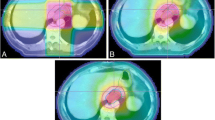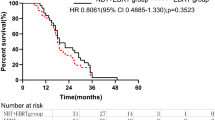Abstract
Introduction
Ninety percent of oesophageal cancers are locally advanced at diagnosis, and treatment yields discouraging results. High dose rate brachytherapy (HDR-BT) permits an increment of local doses without a significant increment of toxicity. The goal of our study is to compare different HDR-BT fractions and assess global survival (GS) and cause-specific survival (CSS).
Material and methods
Twenty-six patients were treated for locally advanced oesophageal cancer with chemotherapy concomitant with conformal three-dimensional radiotherapy (C3DR) from January 1994 to December 2000. Of this group, 96.2% were males, mean age 63.08 years; the most frequent location was medium third, for 50% of cases. Eighty-four percent of cases were G2-3 epidermoid carcinomas. The administration consisted of 44.2 Gy with C3DR and 5 applications of HDR-BT of 500 cGy each.
Results
Actuarial GS and CSS at 5 years is 10.18% and 12.96%, a mean survival of 25.68 and 29.14 months respectively. The following factors (C3DR total dose, fraction dose and total dose of HDR-BT, number of applications, active length of application, total dose of C3DR plus HDR-BT, and BED of HDR-BT) are evaluated to find if they have an influence on treatment response, GS and actuarial CSS. The only result that yields statistical significance, in univariant analysis, is the active length in HDR-BT, thus for a greater active length of application, a minor response is obtained and GS diminishes (p=0.05). We grouped BT fractions on biological equivalent dose (BED) into: <28, 28–33 and >33 Gy; mean survival and GS at 5 years increases with BED≥28 Gy (p=0.016).
Conclusion
Tumour response increases (complete and partial) when BED on HDR-BT is increased, regardless of the fraction employed. A BED higher than 28 Gy yields a significant increase of mean survival and GS at 5 years (p=0.016).
Similar content being viewed by others
References
Jemal A, Thomas A, Murray T et al (2002) Cancer statistics 2002. CA Cancer J Clin 52:23–47
Daly JM, Karnell LH, Menck HR (1996) National cancer data base report on esophageal carcinoma. Cancer 78:1820–1828
Lagergren J, Bergstrom R, Lindgren A et al (1999) Symptomatic gastroesophageal reflux as a risk factor for esophageal adenocarcinoma. N Engl J Med 340:825–831
Koop H (2002) Gastroesophageal reflux disease and Barrett’s esophagus. Endoscopy 34:97–103
Earlam R, Cunha-Melo JR (1980) Oesophageal squamous cell carcinoma: II. A critical view of radiotherapy. Br J Surg 67:457–461
Muller JM, Erasmo H, Stelzner M et al (1990) Surgical therapy of oesophageal carcinoma. Br J Surg 77:845–857
Roth JA, Putnam JB Jr (1994) Surgery for cancer of the esophagus. Semin Oncol 21:453–461
Wobst A, Audisio RA, Colleoni M et al (1998) Oesophageal cancer treatment: studies, strategies, facts. Ann Oncol 9:931–942
Herskovic A, Marz K, Al-Sarraf M et al (1992) Combined chemotherapy and radiotherapy compared with radiotherapy alone in patients with cancer of the esophagus. N Engl J Med 326:1593–1598
Kelsen DP, Ginsberg R, Pajak TF et al (1998) Chemotherapy followed by surgery compared with surgery alone for localized esophageal cancer. N Engl J Med 339:1979–1984
Clark P (2001) Surgical resection with or without pro-operative chemotherapy in oesophageal cancer: an updated analysis of a randomized controlled trial conducted by the UK Medical Research Council Upper GI Tract Cancer Group. Proc Am Soc Clin Oncol 20:126 a (abstract 502)
Urba SG, Orringer MB, Turrisi A et al (2001) Randomized trial of preoperative chemoradiation versus surgery alone in patients with locoregional esophageal carcinoma. J Clin Oncol 19:305–313
Heath EI, Burtness BA, Heitmiller R et al (2000) Phase II evaluation of preoperative chemoradiation and postoperative adjuvant chemotherapy for squamous cell and adenocarcinoma of the esophagus. J Clin Oncol 18:868–876
Cooper JS, Guo MD, Herskovic A et al (1999) Chemoradiotherapy of locally advanced esophageal cancer: Long-term follow-up of a prospective randomized trial (RTOG 85-01). JAMA 281:1623–1627
De-Ren S (1989) Ten years follow-up of esophageal cancer treated by radical radiation therapy: analysis of 869 patients. Int J Radiat Oncol Biol Phys 16:329–334
Maingon P, d’Hombres A, Truc G et al (2000) High dose rate brachytherapy for superficial cancer of the esophagus. Int J Radiat Oncol Biol Phys 46:71–76
Delcambre C, Jacob JH, Portier D et al (2001) Localized squamous-cell cancer of the esophagus: retrospective analysis of three treatment schedules. Radiother Oncol 59:195–201
Tai P, VanDyk J, Yu E et al (1998) Variability of target volume delineation in cervical esophageal cancer. Int J Radiat Oncol Biol Phys 42:277–288
Yu E, Dar R, Rodrigues GB et al (2004) Is extended volume external beam radiation therapy covering the anastomotic site beneficial in post-esophagectomy high risk patients? Radiother Oncol 73:141–148
Kato H, Tachimori Y, Watanabe H et al (1998) Anastomotic recurrence of esophageal squamous cell carcinoma alter trasnthoracic oesophagectomy. Eur J Cancer 164:759–764
Kyriazanos ID, Tachibana M, Shibakita M et al (2003) Pattern of recurrence after extended esophagectomy for squamous cell carcinoma of the esophagus. Hepatogastroenterology 50:115–120
Minsky BD, Pajak TF, Ginsberg RJ et al (2002) INT 0123 (Radiation Therapy Oncology Group 94-05) phase III trial of combined-modality therapy for esophageal cancer: High-dose versus standard-dose radiation therapy. J Clin Oncol 20:1167–1174
Okawa T, Dokiya T, Nishio M et al (1999) Multi-institutional randomized trial of external radiotherapy with and without intraluminal brachytherapy for esophageal cancer in Japan. Int J Radiat Oncol Biol Phys 45:623–628
Yorozu A, Dokiya T, Oki Y (1999) High-dose-rate brachytherapy boost following concurrent chemoradiotherapy for esophageal carcinoma. Int J Radiat Oncol Biol Phys 45:271–275
Okawa T (1999) Clinical optimization study of radiotherapy for esophageal cancer. J Jpn Soc Ther Radiol Oncol 11:53–58
Akagi Y, Hirokawa Y, Kagemoto M et al (1999) Optimum fractionation for high-dose-rate endoesophageal brachytherapy following external irradiation for early stage esophageal cancer. Int J Radiat Oncol Biol Phys 43:525–530
Calais G, Dorsal E, Louisot P et al (1997) Radiotherapy with high dose rate brachytherapy boost and concomitant chemotherapy for stages IIB and III esophageal carcinoma: results of a pilot study. Int J Radiat Oncol Biol Phys 38:769–775
Hujala K, Sipilä J, Minn H et al (2002) Combined external and intraluminal radiotherapy in the treatment of advanced oesophageal cancer. Radiother Oncol 64:41–45
Sur RK, Levin CV, Donde B et al (2002) Prospective randomized trial of HDR brachytherapy as a sole modality in palliation of advanced esophageal carcinoma — an International Atomic Energy Agency study. Int J Radiat Oncol Biol Phys 53:127–133
Hishikawa Y, Kurisu K, Taniguchi M et al (1991) High-dose-rate intraluminal brachytherapy (HDRIBT) for esophageal cancer. Int J Radiat Oncol Biol Phys 21:1133–1135
Datta NR, Kumar S, Nangia S et al (1998) A non-randomized comparison of two radiotherapy protocols in inoperable squamous cell carcinoma of the oesophagus. Clin Oncol 10:306–312
Gaspar LE, Nag S, Herskovic A et al (1997) American Brachytherapy Society (ABS) consensus guidelines for brachytherapy of esophageal cancer. Clinical Research Committee, American Brachytherapy Society, Philadelphia, PA. Int J Radiat Oncol Biol Phys 38:127–132
Chirat E (2003) La curiethérapie endo-oesophagienne. Cancer Radiother 7:132–135
Marinello G, Pierquin B, Grimard L et al (1992) Dosimetry of intraluminal brachytherapy. Radiother Oncol 23:213–216
Geh JI, Bond SJ, Bentzen SM et al (2006) Systematic overview of preoperative (neoadjuvant) chemoradiotherapy trials in oesophageal cancer: evidence of a radiation and chemotherapy dose response. Radiother Oncol 78:236–244
Suntharalingam M (2006) Definitive chemoradiation in the management of locally advanced esophageal cancer. Semin Radiat Oncol 17:22–28
Author information
Authors and Affiliations
Corresponding author
Rights and permissions
About this article
Cite this article
López Carrizosa, M.C., Samper Ots, P.M., Rodríguez Pérez, A. et al. High dose rate brachytherapy (HDR-BT) in locally advanced oesophageal cancer. Clinic response and survival related to biological equivalent dose (BED). Clin Transl Oncol 9, 385–391 (2007). https://doi.org/10.1007/s12094-007-0071-y
Received:
Accepted:
Published:
Issue Date:
DOI: https://doi.org/10.1007/s12094-007-0071-y




